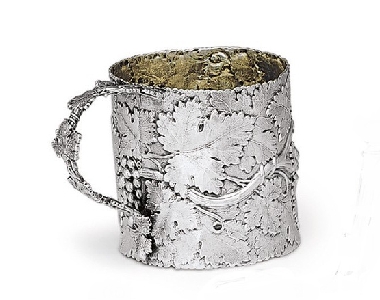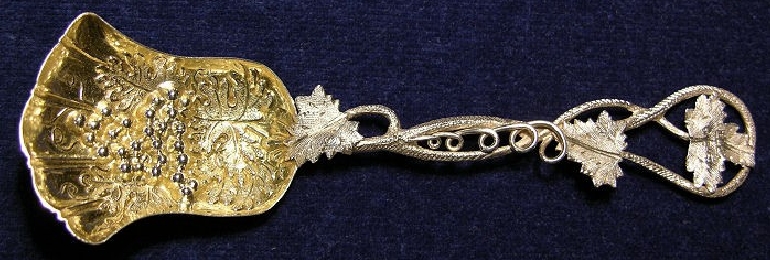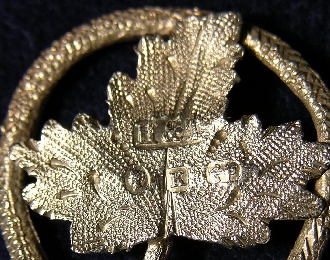My Gallery - Rococo Revival Style Naturalistic Silverware
Convolvulus Flower Master Salt of 1792, London with en suite Salt Spoon by Edward Pairpoint, 1850, London
This Master Salt formed as a large convolvulus flower was made at London in 1792. The time this was made is 3 years after the year of French Revolution when the traditional Rococo design was already out of date. Neo-Classical design dominated objects of art while the Industrial Revolution lead more simple design fitting with mass-production techniques. Against this trend some ambitious silversmiths, especially in the newly established industrial centre of Birmingham, tried to invent the new designs clearly distinguishing themselves from the traditional competitors. This convolvulus design is one of the most successfully innovated naturalistic design around 1790s and became to be replicated during Rococo revival period in 1830-1860s. The identical Master Salt cellar of 1832 by William Bateman Junior is mentioned in Snodin's "English Silver Spoon".
This salt measures two inches tall and approximately 3 & 3/4 inches at its widest and its original fire gilding is still intact.
En suite salt spoon with convolvulus stem and a gilt flower-shaped bowl was made by Edward Pairpoint, London, in 1850. This was designed en suite with the salt cellar, possibly complement the missing original salt spoon. This design is identical with a salt spoon by William Bateman in 1832 mentioned in Snodin's book. The spoon is 4 inches long.
The finest design continues to live and attract people through the history.
Silver-gilt Caddy Spoon by Joseph Willmore
A partially gilt silver caddy spoon with gilded leaf shaped bowl with wonderful embossed grapes and foliage and wireform terminal was made by Joseph Willmore, Birmingham in 1810.
Dimensions: 73 mm long; 9g weight.
A Grapevine Pattern Silver Child's Mug by Joseph Willmore in 1827
A William IV Silver Child's Mug, mark of Joseph Willmore, Birmingham, 1827.
Cylindrical, the body and handle formed as grapevine, marked under base. High: 6cm, Diameter base/top: 5.7cm, Weight: 85.0 grams / 3. oz.
 This is a little bit larger version of the Child's Mug made by Joseph Willmore, dated in 1831, 2 7/8 in. (7 cm.) high; 5 oz. 10 dwt. (178 gr.), which was in The Collection of Benjamin F. Edwards III, was auctioned in Christie's New York on 26 January 2010. Its was sold at $2,750 against its estimate price $1,200 - $1,800.The same design but a little bit larger version of this Child's Mug, dated in 1831, 2 7/8 in. (7 cm.) high; 5 oz. 10 dwt. (178 gr.), which was in The Collection of Benjamin F. Edwards III, was auctioned at Christie's New York on 26 January 2010. Its was sold at $2,750 against its estimate price $1,200 - $1,800. Its provenance was described that "Works of Art from the Collection of the late Paul Wallraf, sold Sotheby's, London, 8 December 1983, lot 67. With Alastair Dickenson, London".
This is a little bit larger version of the Child's Mug made by Joseph Willmore, dated in 1831, 2 7/8 in. (7 cm.) high; 5 oz. 10 dwt. (178 gr.), which was in The Collection of Benjamin F. Edwards III, was auctioned in Christie's New York on 26 January 2010. Its was sold at $2,750 against its estimate price $1,200 - $1,800.The same design but a little bit larger version of this Child's Mug, dated in 1831, 2 7/8 in. (7 cm.) high; 5 oz. 10 dwt. (178 gr.), which was in The Collection of Benjamin F. Edwards III, was auctioned at Christie's New York on 26 January 2010. Its was sold at $2,750 against its estimate price $1,200 - $1,800. Its provenance was described that "Works of Art from the Collection of the late Paul Wallraf, sold Sotheby's, London, 8 December 1983, lot 67. With Alastair Dickenson, London".
A Joseph Willmore beaker of this design, of 1832, is illustrated in Vanessa Brett, The Sotheby's Directory of Silver, 1600-1940, 1986, p. 265, no. 1210.
Compared with those ones, this was the earlisest and seems to be the original of grapevine pattern child's mug by Joseph Willmore.
A small pair of Sugar Tongs by Joseph Willmore, 1829
A small pair of sugar tongs by Joseph Willmore, Birmingham, 1829.
Dimensions: 93 mm long; 28g weight.
A Small Silver-Gilt pair of Sugar Tongs by Joseph Willmore, 1829
A small silver-gilt pair of sugar tongs by Joseph Willmore, Birmingham, 1829.
Dimensions: 93 mm long; 28g weight.
Rococo Revival Naturalistic teaspoon by Joseph Willmore
A naturalistic teaspoon by Joseph Willmore, Birmingham, 1830. A large teaspoon with superbly decorated handle and bowl.
Dimensions: 133 mm long; 29g weight.
Naturalistic Salt Spoons by Joseph Willmore
A naturalistic salt spoons formed as flower heads with leaf handles to the stems by Joseph Willmore, Birmingham, 1838.
Dimensions: 78 mm long; 25g weight.
Rococo Revival Naturalistic pair of Sugar Tongs by Joseph Willmore
A Naturalistic pair of sugar tongs by Joseph Willmore, Birmingham, 1840.
Dimensions: 139 mm long; 86 g weight.
Bottle Label by Joseph Willmore, 1843
Naturalistic pattern bottle labels, one by Joseph Willmore in 1843, the other by the makersmark "N & W".
Dimensions: long 42 mm, width 37 mm.
Left: N & W 1845?, Right: Joseph Willmore 1843.
Rococo Naturalistic Silver Urn by E. J. Barnard, 1833
A Capped Urn made by Edward, Edward junior, John & William Barnard, London, 1833. Engraved with the crest and coat of arms of Sir William Henry Tate(1819–1899), 1st Baronet, and his motto: "Thincke And Thancke". This is one of the most beautiful Rococo naturalistic design in Rococo revival period. Size: 15" high x 12" across the handles; 2525 gm; 81.2 tr. oz.
6 silver-gilt Naturalistic Teaspoons and a pair of Sugar Tongs by Robert Garrad II
A set of 6 silver-gilt naturalistic teaspoons and a pair of tea tongs was made by a famous crown jweller Robert Garrard II, London, in 1854. The Crown Jeweller of the UK is charged with the upkeep of the British Crown Jewels and Garrard was in the honorable status from 1843 to 2007.
Dimensions of a pair of sugar tongs: 132mm long; 49g weight
Dimensions of a spoon: 132mm long; 19g weight
Naturalistic Caddy Spoon, Sugar Spoons and Sugarshifter by Hilliard & Thomason
Hilliard & Thomason, in Birmingham, is renowned for its specific naturalistic design with vine leaves and tendrils decorated stem and delicate decoration by the fly press which was created early 1850s. This design was producted until late 1880s however the machinerization deprived of its original beauty around late 1860s onwards. Biringham silversmiths, lead by Matthew Bolton, agressively applied scientific techniques explored through the 18th century industrial revolution and innovated the silver production process and more importantly developed new beautiful designs.
Caddy Spoon
The gilded bowl finely decorated with various shells - the handle nicely formed as a stalk with lilly pads - by Hilliard & Thomason, Birmingham 1852. These were some of the most expensive caddy spoons to produce requiring a great deal of hand finishing - the small split visible on one shoulder probably resulting from the stress created by the fly press.
Dimensions: 83 mm long; 13g weight.
Caddy spoon by Hilliard & Thomason, Birmingham, 1852
 Caddy spoon by Hilliard & Thomason, Birmingham, 1852
Caddy spoon by Hilliard & Thomason, Birmingham, 1852
Sugar Spoons
A fine victorian sugar spoon of naturalistic form - the gilded bowl embossed with fruiting vine - the stem formed as leafy tendrils, by Hilliard & Thomason, Birmingham, in 1854 and in 1859.
 Sugar spoon by Hilliard & Thomason, Birmingham, 1859
Sugar spoon by Hilliard & Thomason, Birmingham, 1859
 Sugar spoon by Hilliard & Thomason, Birmingham, 1859
Sugar spoon by Hilliard & Thomason, Birmingham, 1859
Sugar Sifter Ladle
This scarce and very desirable Solid Silver sugar sifter ladle with its Naturalistic vine leaves and tendrils decorated stem and its gilt bowl pierced and chased as a vine leaf was made in 1853 by the two Birmingham silversmiths Hilliard & Thomason who were renowned for this fine craftsmanship.
There are two tiny stress-cracks at the join of the stem and bowl, only visible under magnification, but do not detract the appearance of the spoon and, it must be emphasised that they have certainly not affected the strength of the join, bowl to stem, which remains as strong as new.
This Naturalistic design, first produced in the early 1850’s is so fine and so delicate that so few of this design have survived over the years.
This fruit – sugar sifter spoon with no repairs, no wear and no kinks/twist is overall in excellent condition.
The bowl with less than the usual surface scratches has no distortion, its rim has no signs of wear and the piercing has no cracks/splits.
The hallmarks are crisp and clear.
Measurements: 14.2 cms , weight : 17.7 grms, ( 0.62 Troy oz). These size and weight are the norm for this kind of design.
Condition : EXCELLENT
Hallmarks : English hallmarked, Lion Passant (guaranteeing Sterling 925 standard Silver), letter ‘E’ for the year 1853, Assay Office Birmingham and the makers’ mark ‘H & T’ for the silversmiths Hilliard & Thomason.
Sugar Sifter ladle by Hilliard & Thomason, Birmingham, 1853
Cast partially-gilt Embossed Vine pattern sugar spoon, Hilliard & Thomason, 1853
.
This type of design is very rare among works of Hilliard & Thomason. As usually the silver gilt bowl and the silver-gilt tendril stem are separately chased and jointed as usual, however this sugar spoon has the additional thick silver stem decorated with embossed vine pattern.
Dimensions: 152 mm long; 22g weight.
Partially-gilt silver Naturalistic Salt Spoon by Hilliard & Thomason, 1852
Salt Spoon with convolvulus stem and a gilt flower-shaped bowl by Hilliard & Thomason, Birmingham, 1852. It's 9.4 cm long.
Naturalistic Sugar Tong by Hilliard & Thomason, 1853
A pair of sugar tong by Hilliard & Thomason, Birmingham, 1853.
Dimensions: 116mm long; 39g weight.
Naturalistic Sugar Tong by Hilliard & Thomason, circa 1870
This pair of sterling silver sugar tongs was made in 1870s possibly. It bears hallmarks of the Birmingham silversmiths Hilliard and Thomason who were well known for the quality of their decoration - particularly on items of serving cutlery. They also bear the hallmarks - Queen Victoria's head and lion passant. There is no town mark or date letter on these tongs, but the marks as described are on the inside of the bowls. The decoration is of entwined leaves and flowers.
Dimensions: 115mm, Weight: 42.5g
A pair of silver-gilt dessert spoons by HW & Co., Shefield, 1859
This fine pair of cast Victorian silver gilt leaf and vine shaped fruit spoons were made in Sheffield in 1859 by HW&Co and measure 7.75 inches in length and have bowls that are fashioned as vine leaves with the stems being fashioned as vines, leaves and bunches of grapes. They are fully and clearly hallmarked to the backs of the bowls and have a matt gilt finish with no signs of wear and are in excellent condition with no damage or repairs literally like the day they were made .
Pierced Vine Pattern Desert Spoon by Francis Higgins, 1888
The extensive use of vine pattern (sometimes called Pierced Vine, as here, or Bright Vine when unpierced) began in the first decade of the nineteenth century and was generally confined to dessert sets, teaspoons, and other small spoons. These rather ostentatious serving spoons show how the vine tendrils became less formalized and symmetrical under the influence of naturalism. The most showy, and some of the most original, nineteenth century flatware designs were used on dessert services, which were frequently gilt to prevent staining.
Dimensions: 178mm long; 66g weight
Silver-Gilt Naturalistic Tea Straier by Mauzel Manufacturing Co. in 1890s.
THE MAUSER MANUFACTURING COMPANY was founded in North Attlenboro, MA in 1887 and transferred in New York in 1890. In 1903 Mauser Mfg.Co. merged with Hayes & Mc Farland Company and Roger Williams Silverware Company to form the Mt. Vernon Company Silversmiths Inc. The company was purchased by Gorham Corporation in 1931.
OVAL SOLID SILVER FRUIT DISH - CIRCA 1890
 Uknown maker, Austro Hungarian or German, Circa 1890
Uknown maker, Austro Hungarian or German, Circa 1890
A oval dish of rustic design depicting grapes amongst vine and leaf body. Crested and in great condition. A couple of old solder repairs to sides of handles. 3 nuts missing.
Measurements: 30.5cm long, 18.9cm wide
Weight: 202g
.
 Top
Top Site Map
Site Map References
References About Me
About Me